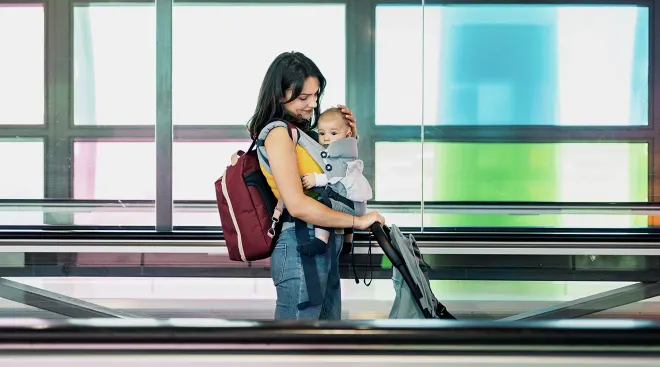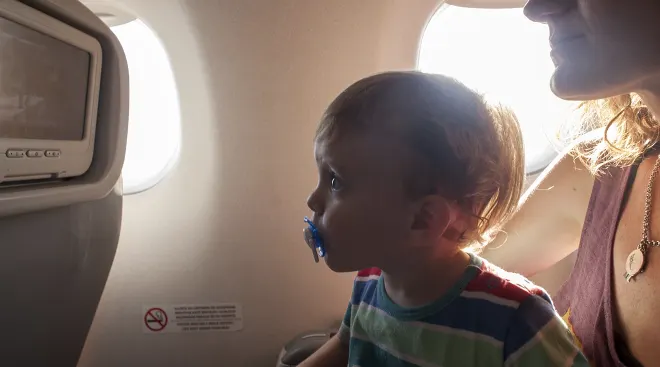Do Babies Need Passports to Travel Internationally?
Before traveling internationally with baby for the first time, you might wonder: Do babies need passports? While your adorable little one might not even sit up or crawl yet, they do need a passport to travel abroad just like everyone else. Thankfully, the process is pretty straightforward. With the help of insiders and experts, we broke down the steps to getting a passport for baby. Read on to learn what you need to do, so you can jetset wherever your heart desires with baby in tow.
First things first: Do babies need passports for travel? Simply put, just like you, baby needs a passport if they’ll be traveling to another country—whether they’re a few weeks or a few months old.
Good news if you’re flying from coast to coast: Babies do not need passports to travel domestically. In most cases children under 18 don’t need to show ID to travel within the US, according to a State Department spokesperson.
By the way, if you’re planning on getting baby a passport, you might want to look into getting them a passport card, which is the size of a driver’s license and fits easily into your wallet. If you’re going to drive or travel by ship—and only plan to visit Canada or Mexico—a passport card might be all baby needs. But if you’re going to take any flights at all, you’ll need a standard passport book. (FYI: A passport card is $15 for a baby, while a passport book costs $100—plus a $35 execution fee for either one.)
Do babies need passports for cruises?
Planning to vacation on the water? You might be confused whether baby needs a passport to cruise. The State Department recommends that everyone who’s taking a cruise from the US that includes international destinations have a passport book on-hand. Although some “closed-loop” cruises—cruises that start and end at the same US port—may not require a passport, the State Department spokesperson says it’s best to bring baby’s (and yours, of course) in case of an emergency, like an unexpected flight evacuation or the ship docking at an alternate port. Also, your cruise company might require a passport, even if customs doesn’t, so you’ll want to do your due diligence.
Babies do need passports for international travel. The first thing to keep in mind is that to get a passport for baby, you have to apply in-person, since kids under 16 aren’t eligible to apply for or renew passports by mail. Here are the steps you’ll need to take:
1. Fill out the baby passport application form
First, you’ll need to fill out baby’s passport application—after all, they likely can’t fill it out themselves. You can download and print the form on the State Department website. Along with it, you’ll need to submit an original or certified document that proves baby is a US citizen, such as a birth certificate, as well as a photocopy. When you print out your application, don’t sign it yet: You’ll have to do this in front of a passport acceptance agent, says Laurie Lee, the cofounder and CEO of Swift Passport & Visa Services in Chicago.
A little advice from someone who’s been through it before: Don’t forget that you need baby’s social security number to apply. “We didn’t realize this, and I lost our daughter’s social security card while I was in a newborn haze,” says Kiersten Brooke DeCook, founder of Kiersten Brooke Travels, a popular baby travel blog, and mom of a well-traveled 2-year-old. “We didn’t know her social security number for our appointment… We got denied applying for the passport that day, had to reschedule, order a new social security card that took weeks to come in and barely received her passport in time for our first trip abroad with her! Don’t make the same mistake I did and put that social security card in a safe space right when you receive it.”
2. Make sure you know the requirements for parents
For children under 16, two parents or guardians generally have to apply in-person with the child, according to the State Department. You’ll have to show proof of your parental relationship with an original or certified copy of baby’s US or foreign birth certificate, adoption decree or a divorce-and-custody decree. Come with an original form of your government-issued ID, along with a photocopy. If you have sole legal authority over baby, you’ll have to submit evidence, such as a birth certificate listing you as the only parent. If the other parent has died, you’ll need to show a copy of their death certificate. If only one parent or guardian can be there in person, you’ll have to submit a special consent form.
3. Prepare your baby passport photo
You’ll have to provide one baby passport photo with your application. (See more guidelines on passport photos below!) Don’t attach or staple your photo to the form.
4. Prepare to pay the passport application fee
You’ll need to pay an application fee, an acceptance fee and additional fees if you’d like expedited processing. Make sure to bring checks with you when you go to the passport facility.
5. Apply for baby’s passport in-person
Now it’s time to find a facility where you can apply for your baby passport, such as a post office or a public library. Some of these facilities require appointments, while others don’t. You can search for one on the State Department’s database.
6. Track the baby passport application status
You can track the baby passport application status on the State Department website.
For many parents, taking a baby passport photo can be nerve-wracking since babies aren’t exactly known for sitting still or following directions. But Laura Pascarella, chief for community relations for passport services of the Bureau of Consular Affairs at the State Department, assures that the requirements are pretty straightforward. “Kiddos can be challenging for all of us to control in full,” she says. “There’s a reasonable amount of leeway that we try to give our teams… particularly when it comes to infants.”
That said, your baby passport photo does need to follow these guidelines:
- It should be a color photo, taken in the last six months
- It should show a clear image of baby’s face, without any objects like pacifiers or binkies. No one else should be in the photo
- Make sure baby is facing forward with a neutral facial expression. “It’s acceptable if the infant’s eyes (particularly a newborn’s) aren’t entirely open,” according to the State Department. Baby’s face should be in focus and not blurry
- Use a white or off-white background without shadows, texture or lines. You can lay baby on their back on a sheet, or cover a car seat with a sheet and take a picture of baby sitting in it. “If your little one is wiggly for the photo or won’t cooperate, try hiding under a white sheet while holding them in your lap and then snap the photo,” suggests DeCook. “You can also try holding them on your shoulders in front of a white background!”
- The photo size should be 2 by 2 inches, printed on matte or glossy photo-quality paper
That said, don’t stress: The requirements for young children are a tad more lenient. “My nephew, when he was 3 he got the most ridiculous passport photo I’ve ever seen,” laughs Lee. “He looks like he’s in the middle of a tantrum, and it’s the cutest freaking passport I’ve ever seen in my life. … But yeah, they allowed it.”
The State Department regularly posts updated estimated processing times: Currently, for example, it takes 10 to 13 weeks to process a routine passport application and seven to nine weeks for expedited processing, which costs an extra $60. If you’re traveling in 14 days or less, you might be able to call and get one of the limited appointment times provided—but it’s not guaranteed.
Of course, it’s always best to apply early: “The best advice we can give is to be thinking about your passport even before you’re thinking about booking the actual trip,” says Pascarella. “Applying about six months in advance is going to set a family up not only for success, but for less stress.”
Lee says that if you need a passport before the State Department can expedite it on time, you can make use of a passport and visa expediting service. She adds that even if you use an expediting service, you still have to go to an official passport acceptance agent.
Don’t be alarmed if the baby passport arrives but your supporting documents (i.e. baby’s birth certificate) aren’t included in the envelope. It can take up to eight weeks for these to be returned, according to the State Department.
Passports for children under 16 are only valid for five years, while adult passports are valid for 10. “That is intentional,” says Pascarella. “That’s because children grow and they change. So the photo needs to be an accurate representation of who they are.” She adds: “But we also understand that an infant aged 6 months is not going to look identical to a 4-year-old toddler, and that passport could still be used in both of those cases.”
Once you actually get baby’s passport, you’ll likely breathe a sigh of relief—and feel proud of accomplishing this major milestone. It’s time to pack those bags and set off on your journey.
About the experts:
Kiersten Brooke DeCook is the founder of Kiersten Brooke Travels, a popular baby travel blog, and mom of a well-traveled 2-year-old named Adaline.
Laurie Lee is the cofounder and CEO of Swift Passport & Visa Services in Chicago.
Laura Pascarella is chief for community relations for passport services of the Bureau of Consular Affairs at the U.S. State Department.
Plus, more from The Bump:
Navigate forward to interact with the calendar and select a date. Press the question mark key to get the keyboard shortcuts for changing dates.




















































